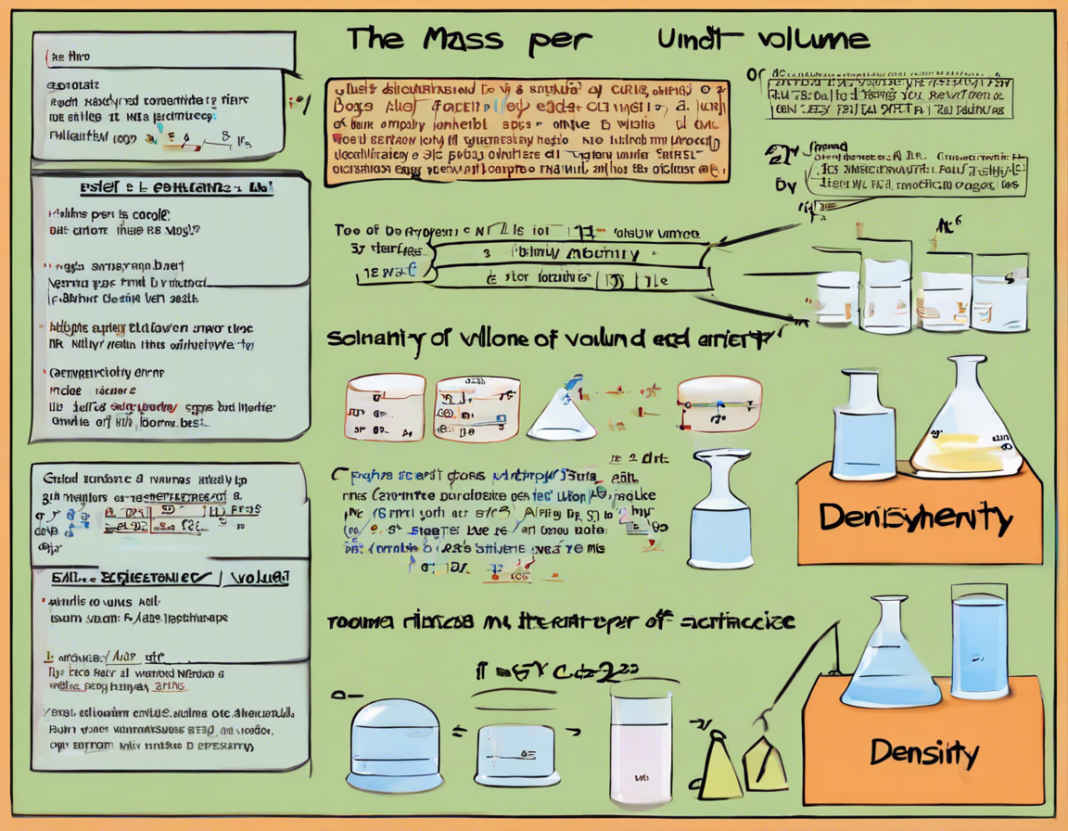Density is a fundamental concept in chemistry that plays a crucial role in various scientific disciplines. It is defined as the mass of an object per unit volume and is commonly denoted as mass/volume (kg/m³ or g/cm³). Understanding density is essential for students and researchers alike as it helps in identifying substances, predicting their behavior, and conducting experiments effectively. In this article, we will delve into the concept of density in detail and explore its significance in chemistry.
What is Density?
Density is a physical property that describes how much mass is packed into a given volume. It is calculated by dividing the mass of an object by its volume. The formula for density (ρ) is:
[ \text{Density (ρ)} = \frac{\text{Mass (m)}}{\text{Volume (V)}} ]
The SI unit for density is kilograms per cubic meter (kg/m³), although other units like grams per cubic centimeter (g/cm³) are also commonly used.
Importance of Density in Chemistry
Density is a critical parameter in various fields of chemistry, including analytical chemistry, materials science, and environmental science. Here are some key reasons why density is important in chemistry:
1. Identifying Substances
The density of a substance is a unique characteristic that helps in its identification. Different substances have different densities, allowing chemists to distinguish between them based on their physical properties.
2. Quality Control in Industry
In industrial settings, density measurements are used for quality control purposes. By comparing the measured density of a sample with a standard value, manufacturers can ensure the consistency and purity of their products.
3. Formulation of Mixtures
In chemical reactions and formulation of mixtures, knowing the density of each component is essential for determining the appropriate proportions and predicting the final properties of the mixture.
4. Characterization of Materials
Materials scientists use density measurements to characterize and classify materials based on their composition and structure. Differences in density can reveal important information about the microstructure and properties of materials.
5. Solubility and Concentration
Density plays a role in determining the solubility of substances in a solvent and in calculating the concentration of solutions. Solutions with higher concentrations often have higher densities due to the increased mass of dissolved solutes.
6. Density Gradients in Laboratories
In laboratory techniques such as density gradient centrifugation, the separation of components in a mixture is based on their differences in density. This technique is widely used in biochemistry and molecular biology for purifying biological molecules.
Factors Affecting Density
Several factors influence the density of a substance. It is important to understand these factors to interpret density measurements accurately. Some of the key factors affecting density include:
1. Temperature
Temperature has a significant impact on the density of solids, liquids, and gases. In general, most substances expand when heated and contract when cooled, leading to changes in density.
2. Pressure
For gases, changes in pressure can alter their density. As pressure increases, the molecules are pushed closer together, increasing the density of the gas.
3. Composition
The types of atoms or molecules present in a substance influence its density. For example, isotopes of an element may have different densities due to variations in atomic mass.
4. Crystalline Structure
In solids, the arrangement of atoms in the crystal lattice affects the density of the material. Different crystal structures can result in variations in density.
5. Purity
Impurities in a substance can affect its density. The presence of impurities may increase or decrease the density of a material depending on the nature of the impurities.
Density Calculations and Examples
Calculating density involves measuring the mass and volume of a substance and then applying the formula ρ = m/V. Here are some examples of density calculations:
Example 1: Calculating the Density of a Solid
Suppose you have a piece of iron with a mass of 120 grams and a volume of 50 cm³. The density of iron can be calculated as:
[ \text{Density of Iron} = \frac{120 \, \text{g}}{50 \, \text{cm³}} = 2.4 \, \text{g/cm³} ]
Example 2: Calculating the Density of a Liquid
For a liquid sample weighing 80 grams and occupying 100 mL, the density can be determined as:
[ \text{Density of Liquid} = \frac{80 \, \text{g}}{100 \, \text{mL}} = 0.8 \, \text{g/mL} ]
Example 3: Calculating the Density of a Gas
The density of a gas can be calculated using the ideal gas law, PV = nRT, where P is pressure, V is volume, n is the number of moles, R is the gas constant, and T is temperature.
Common Density Values
It is useful to have a reference for the density of common substances to compare and interpret experimental results. Here are some typical density values for various materials:
- Water: 1 g/cm³ or 1000 kg/m³
- Aluminum: 2.7 g/cm³
- Lead: 11.3 g/cm³
- Air: 0.0012 g/cm³
- Gold: 19.3 g/cm³
- Ethanol: 0.79 g/cm³
- Ice: 0.917 g/cm³
Having a general idea of these values can aid in the quick estimation of densities during experiments or calculations.
Frequently Asked Questions (FAQs) about Density in Chemistry:
1. What is the difference between mass and density?
Mass refers to the amount of matter in an object, measured in units like grams or kilograms, while density is the mass of an object per unit volume, expressed in units such as g/cm³ or kg/m³.
2. How does density change with temperature?
In general, most substances expand when heated and contract when cooled. This results in changes in density, with substances typically becoming less dense as they are heated and more dense as they cool.
3. Why is density an intensive property?
Density is considered an intensive property because it does not depend on the amount of a substance present. Whether you have a small sample or a large sample, the density of the substance remains constant under fixed conditions.
4. How can density be used to distinguish between pure substances and mixtures?
Pure substances have specific and constant densities, while mixtures have variable densities depending on the composition and proportions of the components. By measuring the density of a sample, you can discern whether it is a pure substance or a mixture.
5. Can the density of a substance be negative?
No, density cannot be negative. Since it is a ratio of mass to volume, the density of a substance is always a positive value, even if the mass is negative (which is not physically possible).
6. How can I measure the density of irregularly shaped objects?
To measure the density of irregularly shaped objects, you can use the water displacement method. Submerge the object in a container of water, measure the volume of water displaced, and divide the mass of the object by the volume of water displaced to calculate its density.
7. Why do ships float on water if most metals have higher densities than water?
Ships float on water due to the principle of buoyancy. The weight of the water displaced by the ship is equal to the weight of the ship itself, allowing it to float. The shape and design of the ship ensure that the average density of the ship is lower than that of water.
8. How does density affect the behavior of gases in the atmosphere?
In the Earth’s atmosphere, gases with lower densities tend to rise above gases with higher densities. This phenomenon is known as atmospheric stratification and plays a crucial role in weather patterns and air circulation.
9. Is there a relationship between density and pressure in liquids?
In liquids, density is generally affected by pressure. An increase in pressure leads to a slight decrease in volume, causing the density of the liquid to increase. This relationship is known as compressibility and is more prominent in liquids than in solids.
10. How can density be used in forensic science?
In forensic science, density measurements can help identify unknown substances found at crime scenes. By comparing the density of an unknown substance to a database of known densities, forensic analysts can provide valuable clues about the nature of the substance.
Conclusion
In conclusion, density is a fundamental concept in chemistry that holds significant importance in various scientific fields. By understanding and applying the principles of density, scientists can analyze substances, predict their behavior, and make informed decisions in research and industry. Whether you are a student conducting experiments in the laboratory or a researcher studying complex materials, a solid grasp of density is essential for success in the world of chemistry.











